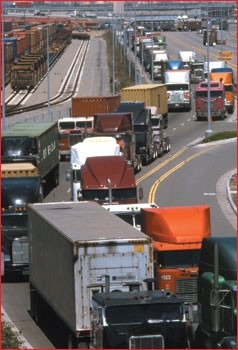
OnTrack2025 IntelliConference
An IntelliConference and Talk Led by Michael Sussman, Founder and CEO, OnTrackNorthAmerica
“How Collaboration, Trust, and Railroads Will Save the World”
Time: 5:30 PM Sharp to 8:00 PM, Eastern Place: Temple University, Science, Education, and Research Center, Hazel M. Tomlinson Lecture Hall, 1st Floor, 1925 N. 12th St., Phila, PA
Cost: Free
Parking: On-street free parking or Montgomery Garage,1859 N.11th St., $10
Food: Dinner sandwiches will be served for in-person attendees
Participation Agreement: See below
Live Streaming: For Zoom Participation, Link Provided Upon Registration
Thank you for engaging with me in this conversation. I am honored to be hosted by Temple University’s Industrial & Systems Engineering Program to present the distillation of my thirty-year exploration of how to solve the world’s challenges. Early in my work in industrial systems, I learned that moving goods on a train saves 50-80% of the diesel fuel and consequent emissions compared to using a truck. I knew that this misuse of the wheel reveals everything that needs to be reoriented for society to deploy capital sustainably—not just financial capital but natural resources, land, and human capital.
In 1914, we had a 240,000-mile robust network of rail lines in the U.S. But instead of intelligently integrating the new trucking industry with railroads, government policies committed to building roads as a public investment. And what was the result of this development? An imbalanced freight system that pitted trucks and railroads against each other—as if this kind of competition is a productive orientation for society. We have been paying the price for that missed opportunity ever since, as the rail network has shrunk to 139,000 route miles. We can fix this. It is time to shift from the fearful rhetoric against “picking winners and losers” to a new era where we consciously and collectively design industrial policies that create “winners and winners.”
Having worked with and learned from over 10,000 individuals on infrastructure projects in 43 U.S. states and Canadian Provinces over the last 30 years, we have invented a practical and immediately productive set of methods and tools for helping communities and stakeholders solve problems and work together. This process, which we named IntelliSynthesis™, is eminently accessible and applicable to all issues.
That is why I am inviting you to this important evening on December 5th. Experience IntelliSynthesis™ for yourself and see how powerful it can be for charting a smarter future. Your unique perspectives and intelligence will make a valuable contribution.
Focusing initially on growing freight rail service will deliver cascading benefits to the economy, environment, and our future quality of life. We don’t have to stick with sub-optimal use of either railroads or highways, and together, we can redesign governance, commerce, industry, and supply chains. We all want to improve our quality of life, combat the climate crisis, and find better ways to co-exist. When we think and plan together with IntelliSynthesis, we have a way forward that vastly improves matters for all of us.
Come to the talk to learn how you can play a role in OnTrack2025, a two-year Action Planning Process for establishing the measures, goals, and design principles for advancing North American freight railroads’ role within a balanced and sustainable multi-modal industrial supply chain system. I look forward to your participation.


Michael Sussman
1700 Sansom St., Suite 701
Philadelphia PA 19103
215-564-3004
msussman@ontracknorthamerica.webaika.com
www.OnTrackNorthAmerica.org
In service to OnTrack2025, OnTrackNorthAmerica is introducing its North American Freight Forum, a new institutional model for the citizenry and their business and government representatives to think together for breakthrough results.
In the face of our seemingly most difficult yet critical issues, such as race relations, gun laws, and abortion, invariably, we hear someone say, “We need to have a national conversation.” But really, where would we have that conversation? Social media, press, courts, the town square?
The North American Freight Forum and OnTrack2025 provide the practical answer to that urgent need for large-scale, multi-stakeholder dialogue that is transparent, inclusive, and efficient.
Participation Agreement
IntelliSynthesis utilizes everyone’s time and intellect smartly, beginning with several fundamental participation agreements. Attendance is free, but more importantly, it requires: 1) commitment to attending unless a personal or professional emergency occurs, 2) arriving early enough to be ready to participate at the scheduled start time of 5:30 PM Eastern, 3) participating until the scheduled end time of 8:00 PM Eastern, 4) not using cell phones or email, and minimizing distractions during the IntelliConference in order to be present physically and mentally, and 5) keeping yourself on video if participating via Zoom.




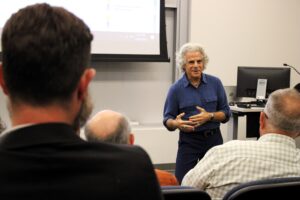 At the heart of OnTrackNorthAmerica’s work is the advancement of collaboration and coordination as a superior orientation for government and business. But before establishing my own confidence in people’s ability to collaborate and work in the community’s best interests, I had to ponder, as many of us do, “Are people inherently altruistic, or are they self-centered?”
At the heart of OnTrackNorthAmerica’s work is the advancement of collaboration and coordination as a superior orientation for government and business. But before establishing my own confidence in people’s ability to collaborate and work in the community’s best interests, I had to ponder, as many of us do, “Are people inherently altruistic, or are they self-centered?”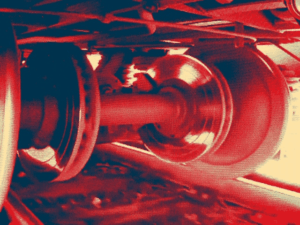
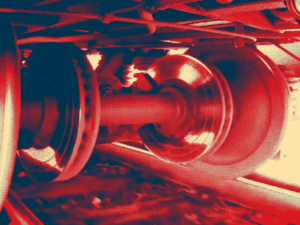 to 1/6 the amount of energy while producing fewer emissions than moving comparable weight over roads.
to 1/6 the amount of energy while producing fewer emissions than moving comparable weight over roads.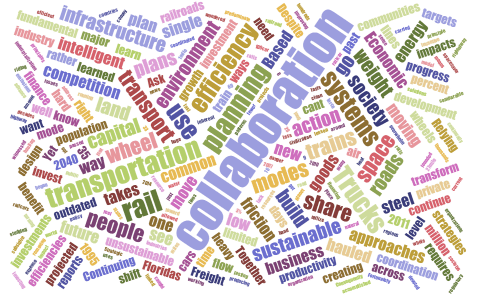
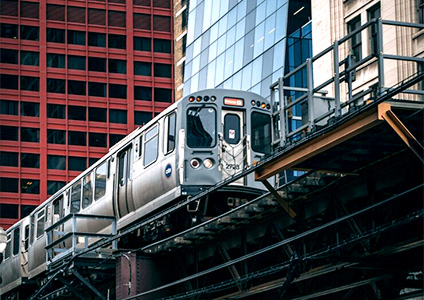




 agree on a set of measures and values to guide these major investments public and private purposes. As yet, the measures, data, and analytical method have not been gathered and agreed on across agency, community, and sector lines. Therefore, system-level as well as individual transportation project investments are challenging to evaluate in cases where researchers, consultants, and decision-makers are unable to agree on a full set of lifecycle costs and benefits. “It’s OTNA’s mission to bridge these gaps and enable us to make better decisions, with broader positive social impact, in a timelier manner” noted Mr. Sussman.
agree on a set of measures and values to guide these major investments public and private purposes. As yet, the measures, data, and analytical method have not been gathered and agreed on across agency, community, and sector lines. Therefore, system-level as well as individual transportation project investments are challenging to evaluate in cases where researchers, consultants, and decision-makers are unable to agree on a full set of lifecycle costs and benefits. “It’s OTNA’s mission to bridge these gaps and enable us to make better decisions, with broader positive social impact, in a timelier manner” noted Mr. Sussman.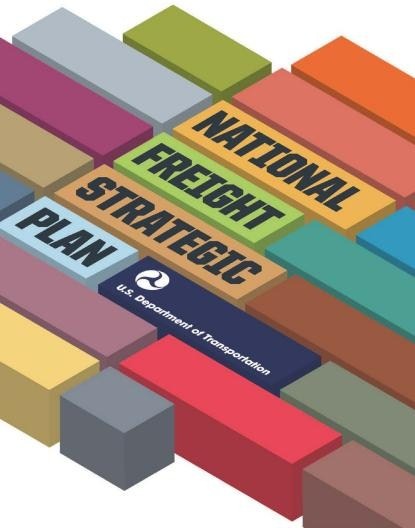
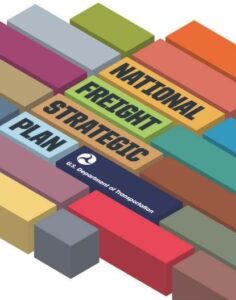
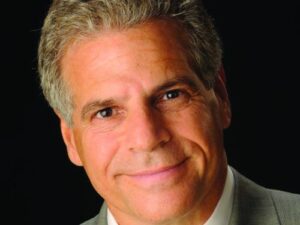
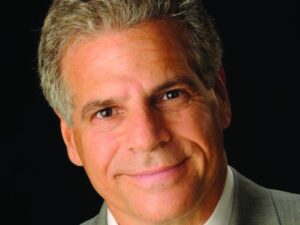 Nonprofit transportation consultancy OnTrackNorthAmerica (OTNA) has entered a strategic partnership agreement with
Nonprofit transportation consultancy OnTrackNorthAmerica (OTNA) has entered a strategic partnership agreement with 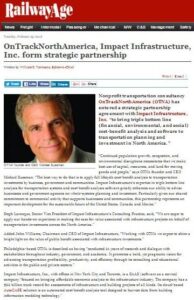 Steph Larocque, Senior Vice President of Impact Infrastructure’s Consulting Practice, said, “We are eager to apply our hands-on experience in making the case for value associated with infrastructure projects on behalf of transportation investments across the North America.”
Steph Larocque, Senior Vice President of Impact Infrastructure’s Consulting Practice, said, “We are eager to apply our hands-on experience in making the case for value associated with infrastructure projects on behalf of transportation investments across the North America.”